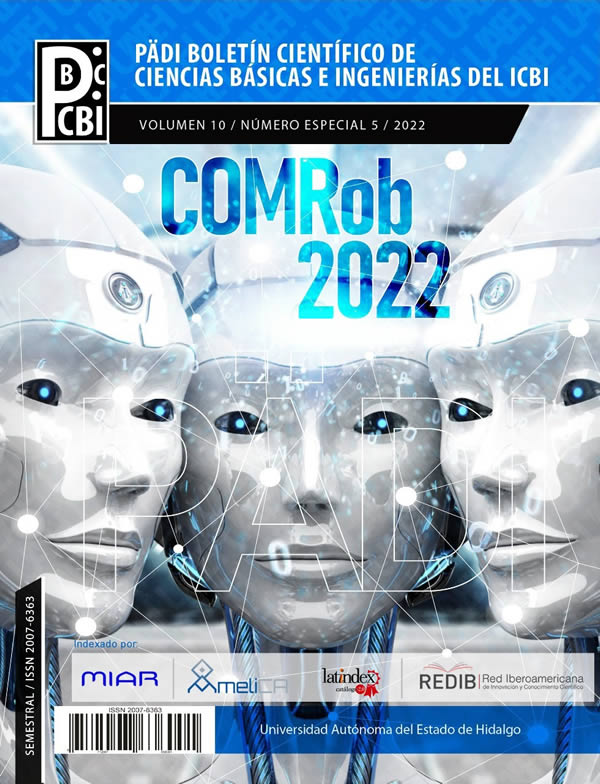Text mining for the study of a state of the art in the use of physiological signals for the detection of emotions: a perspective on human-robot interaction
Abstract
This article presents an approach based on the analysis of abstracts to know the trend of the use of physiological signals, as well as the feasibility of applying these techniques in the induction of emotions and cognitive states in healthy people. The objective of this article is to determine the feasibility of developing technological tools that help detect the emotional and cognitive state of a user when interacting with a robot. For this, initially 8,623 abstracts were collected from the IEEE digital library, which are related
to the topics of neurometrics and biometrics during a period of approximately 50 years ago. However, when analyzing the results, it is concluded that they are of little use for the objective of this research, so the term “emotions” is added in the new search. The article number is reduced to 110, the life cycle model or S curve is reconstructed using the segment of the cubic polynomial. The results show that there is a feasibility and feasibility of considering biometrics and neurometrics in the detection of emotions.
Downloads
References
(2019). Ieee xplore digital library. https://ieeexplore.ieee.org/ Xplore/. Accessed: 2019-03-10. Ali, S. M., Darbar, Z. A., y Junejo, K. N. (2015). Age estimation from facial images using biometric ratios and wrinkle analysis. En 2015 5th National Symposium on Information Technology: Towards New Smart World (NSITNSW), pp. 1–5. IEEE.
Blondet, M. V. R., Laszlo, S., y Jin, Z. (2015). Assessment of permanence of non-volitional eeg brainwaves as a biometric. En IEEE International Conference on Identity, Security and Behavior Analysis (ISBA 2015), pp. 1–6. IEEE.
Bulagang, A. F., Weng, N. G., Mountstephens, J., y Teo, J. (2020). A review of recent approaches for emotion classification using electrocardiography and electrodermography signals. Informatics in Medicine Unlocked, 20:100363.
Chiranjeevi, P., Gopalakrishnan, V., y Moogi, P. (2015). Neutral face classification using personalized appearance models for fast and robust emotion detection. IEEE Transactions on Image Processing, 24(9):2701–2711.
Chuah, S. y Yu, J. (2021). The future of service: The power of emotion in human-robot interaction. Journal of Retailing and Consumer Services, 61:1–8.
García-Martínez, B., Martínez-Rodrigo, A., Alcaraz, R., Fernández- Caballero, A., y Gonz´alez, P. (2017). Nonlinear methodologies applied to automatic recognition of emotions: an eeg review. En International Conference
on Ubiquitous Computing and Ambient Intelligence, pp. 754–765.
Gonzáles-Martinez, A. (2014). Visualización de emociones basado en el modelo de plutchik. Tesis de maestría, IPN, México.
Goyal, G. y Singh, J. (2018). Minimum annotation identification of facial affects for video advertisement. En 2018 International Conference on Intelligent Circuits and Systems (ICICS), pp. 300–305. IEEE.
Hayano, J., Tanabiki, T., Iwata, S., Abe, K., y Yuda, E. (2018). Estimation of emotions by wearable biometric sensors under daily activities. En 2018 IEEE 7th Global Conference on Consumer Electronics (GCCE), pp. 240–
IEEE.
Kaklauskas, A., Ubarte, I., Tupenaite, L., y Raupys, D. (2018). Video neuroadvertising recommender model for a ective bim. En 2018 7th International Conference on Computers Communications and Control (ICCCC), pp.
–251. IEEE.
Khalil, R., Arasteh, A., y Sarkar, A. K. (2017). Eeg based biometrics using emotional stimulation data. En 2017 IEEE Region 10 Humanitarian Technology Conference (R10-HTC), pp. 246–249. IEEE.
Kuhn, T. S. (1970a). The structure of scientific revolutions, volumen 111. Chicago University of Chicago Press.
Kuhn, T. S. (1970b). The structure of scientific revolutions, volumen 111. Chicago University of Chicago Press.
Makagonov, P., Figueroa, A. R., y Gelbukh, A. (2006). Studying evolution of a branch of knowledge by constructing and analyzing its ontology. En International
Conference on Application of Natural Language to Information Systems, pp. 37–45. Springer.
Makagonov, P. y Ruiz Figueroa, A. (2004). Study of knowledge evolution in parallel computing by short texts analysis. En Iberoamerican Congress on Pattern Recognition, pp. 439–445. Springer.
Mavridou, I., McGhee, J. T., Hamedi, M., Fatoorechi, M., Cleal, A., Ballaguer-Balester, E., Seiss, E., Cox, G., y Nduka, C. (2017). Faceteq interface demo for emotion expression in vr. En 2017 IEEE Virtual Reality (VR), pp. 441–442. IEEE.
Moore, E. (2016). Managing the loss of control over cyber identity. En 2016 Third International Conference on Digital Information Processing, Data Mining, and Wireless Communications (DIPDMWC), pp. 233–238. IEEE.
Noyons, E. C. M. (1999). Bibliometric mapping as a science policy and research management tool. Leiden University.
Purnomo, M. H. (2016). Keynote# 1: Limitless possibilities of pervasive computingon biomedical engineering. En 2016 8th International Conference on Information Technology and Electrical Engineering (ICITEE), pp. 1–4. IEEE.
Rahman, M. M., Sarkar, A. K., Hossain, M. A., Hossain, M. S., Islam, M. R., Hossain, M. B., Quinn, J. M., y Moni, M. A. (2021). Recognition of human emotions using eeg signals: A review. Computers in Biology and Medicine,
:104696.
Ruiz Figueroa, A. y Makagonov, P. (2007). Modelos de desarrollo del hardware y software basados en el estudio de computaci´on paralela. Interciencia, 32(3):160–166.
Samona, Y., Pintavirooj, C., y Visitsattapongse, S. (2017). Study of ecg variation in daily activity. En 2017 10th Biomedical Engineering International Conference (BMEiCON), pp. 1–5. IEEE.
Soroush, M. Z., Maghooli, K., Setarehdan, S. K., y Nasrabadi, A. M. (2017). A review on eeg signals based emotion recognition. International Clinical Neuroscience Journal, 4(4):118–129.
Spezialetti, M., Placidi, G., y Rossi, S. (2020). Emotion recognition for humanrobot interaction: Recent advances and future perspectives. Frontiers in Robotics and AI, 7:1–12.
Suhaimi, Nazmi Sofian and Mountstephens, James and Teo, Jason and others (2020). Eeg-based emotion recognition: A state-of-the-art review of current trends and opportunities. Computational intelligence and neuroscience, 2020:1–19.
Varghees, V. N. y Ramachandran, K. (2016). Two-channel heart sound segmentation framework using phonocardiogram and pulsatile signals. En 2016 IEEE Students Technology Symposium (TechSym), pp. 305–310. IEEE.
Wagh, K. P. y Vasanth, K. (2019). Electroencephalograph (eeg) based emotion recognition system: A review. Innovations in Electronics and Communication Engineering, pp. 37–59.
Xu, T., Zhou, Y., Wang, Z., y Peng, Y. (2018). Learning emotions eeg-based recognition and brain activity: A survey study on bci for intelligent tutoring system. Procedia computer science, 130:376–382.














